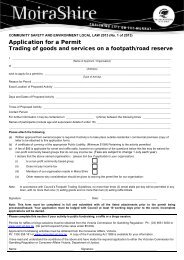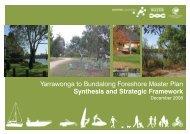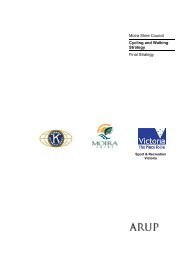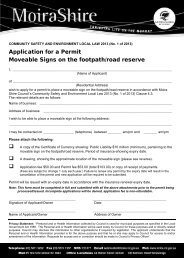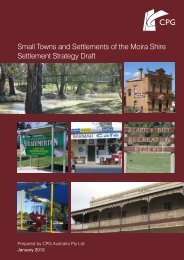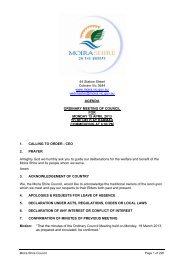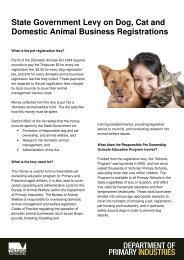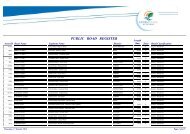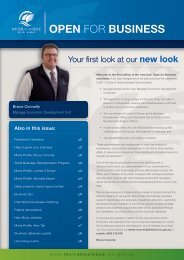Cobram 2025 Cobram Strategy Plan - Moira Shire Council
Cobram 2025 Cobram Strategy Plan - Moira Shire Council
Cobram 2025 Cobram Strategy Plan - Moira Shire Council
You also want an ePaper? Increase the reach of your titles
YUMPU automatically turns print PDFs into web optimized ePapers that Google loves.
<strong>Cobram</strong> <strong>Strategy</strong> <strong>Plan</strong><br />
Final Report<br />
Many rural and regional towns experience a significant decline in the number of<br />
persons within the 18 to 24 years cohort. Since 1986 the proportion of the people<br />
living in <strong>Cobram</strong> within this cohort and the 5 to 17 years cohort has continued to<br />
decline. Whilst this is consistent with the changes to the overall age structure for<br />
Victoria, and indeed being experienced throughout Australia as the “babyboomers”<br />
age, efforts should be made to reverse this decline through new<br />
employment opportunities and further economic development. The lack of tertiary<br />
education facilities and opportunities is a genuine concern amongst the <strong>Cobram</strong><br />
population.<br />
4.4.2 Forecasts 2006 to 2031<br />
Whilst age structure projections are not available specifically for <strong>Cobram</strong>, the<br />
projections for <strong>Moira</strong> <strong>Shire</strong> based on 2001 data (as per the table below) indicate<br />
that it is expected that this trend towards an ageing population will continue. Like<br />
<strong>Moira</strong>, when compared to 2001, by 2031 <strong>Cobram</strong>’s population is expected to have<br />
a higher proportion of those aged over 55 years, with much of the population<br />
growth coming from increases in this age cohort, through ageing and migration.<br />
Table 5: Forecast for Age Structure, 2001 to 2031<br />
<strong>Moira</strong><br />
Reg Vic<br />
Age<br />
Cohort<br />
2001<br />
%<br />
2006<br />
%<br />
2011<br />
%<br />
2016<br />
%<br />
2021<br />
%<br />
2031<br />
%<br />
0-4 6.7 6.1 5.4 5.0 4.9 5.0 4.5<br />
2031<br />
%<br />
5-14 15.1 14.4 13.7 12.5 11.5 11.0 10.4<br />
15-24 10.7 10.3 10.5 10.3 9.9 8.3 9.4<br />
25-34 11.3 10.2 9.0 8.8 8.9 8.7 9.6<br />
35-49 20.5 20.1 19.2 18.0 16.7 15.8 17.9<br />
50-59 12.2 13.5 13.6 13.7 13.3 12.1 12.3<br />
60-69 10.7 11.4 13.2 14.7 15.0 14.9 13.9<br />
70-84 10.8 11.5 12.3 13.3 15.5 18.8 17.4<br />
85+ 1.9 2.4 3.1 3.8 4.3 5.5 4.6<br />
Total 100.0 100.0 100.0 100.0 100.0 100.0 100.0<br />
Source: DSE, Victoria in Future 2004<br />
A major issue for planning for the housing of this group is the desire for many<br />
people to stay at home for as long as possible, with the benefit of Home and<br />
Community Care programs. This is particularly applicable to those people from<br />
remote areas and retired farmers, who wish to remain in familiar areas.<br />
There will be a range of people in this age group, from early retirees that are fully<br />
independent and may combine part time work with leisure activities, to elderly<br />
people who are fully supported. Subsequently the housing and community facility<br />
demands of these sub groups will differ and may include:<br />
© Coomes Consulting Group G:\13\131654\PL11 001 <strong>Strategy</strong> <strong>Plan</strong> Final Report.doc<br />
page 21



